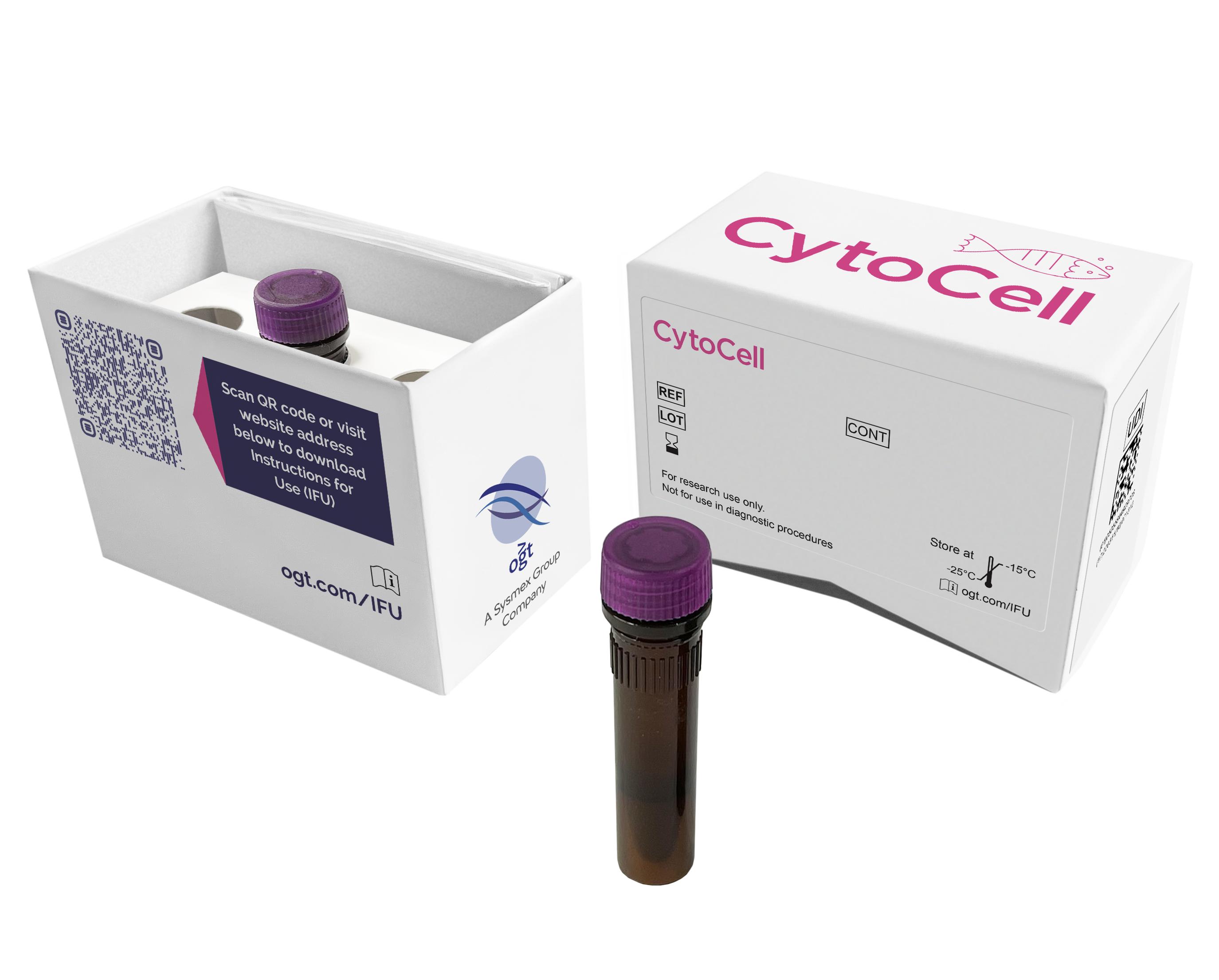
The IGK product consists of a 301kb probe, labelled in red, covering a part of the distal IGK Variable region and a green probe, covering a 606kb region telomeric to the Joining segments and the Constant segment of IGK. The green probe extends from a position that is telomeric to the D2S2216 marker and continues to a position that is centromeric to the D2S2510 marker.
Recurrent rearrangements involving the IGK (immunoglobulin kappa locus) gene at 2p11.2, with a wide range of partner genes, are seen in lymphomas and haematological malignancies.
A large number of B-cell malignancies harbour translocations involving the immunoglobulin (IG) loci. The majority of cases will show rearrangements involving the IGH gene; however, variant translocations have been described in 5-10% of B-cell neoplasms which involve either the immunoglobulin kappa (IGK) light chain locus at 2p11.2 or the immunoglobulin lambda (IGL) light chain locus at 22q111,2.
Variant translocations involving the IG light chain loci are seen in Burkitt lymphoma and multiple myeloma, with the presence of a t(2;8)(p12;q24) MYC-IGK, or t(8;22)(q24;q11) MYC-IGL3,5. In diffuse large B-cell lymphoma (DLBCL), translocations may involve the BCL6 gene via t(2;3)(p12;q27) or t(3;22)(q27;q11) translocations, or the BCL2 gene via t(2;18)(p12;q21) or t(18;22)(q21;q11) translocations6.
Find certificate of analysis documentation for our CytoCell FISH probes

Our lab has been using a wide range of CytoCell FISH probes for a number of years, and have been increasing this range all the time. The probes have clear bright signals and show good reproducibility. CytoCell provides fast delivery of catalogue probes, and are very responsive when we have any queries or problems with their products.

Bridget Manasse
Addenbrookes Hospital, Cambridge University Hosiptals NHS Foundation Trust, UK
In our hands, CytoCell FISH probes have proven to be of the highest quality with bright, easy to interpret signals, thus providing confidence in our results. OGT's customer support is outstanding, as their staff are extremely knowledgeable and truly care about their customers and their customers’ needs.

Jennie Thurston
Director of Cytogenetics, Carolinas Pathology Group, USA
I first came across CytoCell FISH probes in a previous lab I worked in and I was struck by the quality of the products. Since this time, I have been recommending and introducing CytoCell probes across all application areas — now they are the primary FISH probes used in our lab. They have an excellent range of products and their ready-to-use reagent format saves considerable time.

Elizabeth Benner
Medical Technologist, University of Arizona Health Network, USA
We have been working with CytoCell fish probes for two decades because of their excellent clarity and intensity regardless of the size of the probe. It is so clear and simple to detect.
Dr. Marina Djurisic
Head of Laboratory of Medical Genetics, Mother and Child Health Care Institute of Serbia “Dr Vukan Cupic”, Serbia
The quality and consistency of CytoCell’s probes means I can trust the results, and my clients get their results in a timely manner.

Dr. Theresa C. Brown
Director, Cytogenetics Laboratory, Hayward Genetics Center, Tulane University School of Medicine, USA
It was very important for us to have more consistent results with our probes — easy-to-read bright signals and a range of vial sizes, which is much more cost-effective.

Janet Cowan, PhD
Director of the Cytogenetics Laboratory, Tufts Medical Center, USA
Not only do CytoCell offer an extensive range of high-quality FISH probes, the customer support is also excellent — providing fast access to all the probes I need. The probes are highly consistent with bright signals allowing easy scoring of results.
Dr. Eric Crawford
Senior Director, Genetics Associates Inc., USA
The quality and reproducibility of results using the CytoCell kit has been vital in accurately detecting co-deletions in our glioma investigations. We now have a cost-effective test that we can rely on that is also easy to use and interpret. We've been consistently impressed with this kit - not to mention the support offered by OGT's customer service, and have completely transitioned over to CytoCell probes.
Gavin Cuthbert, FRCPath
Head of Cancer Cytogenetics, Northern Genetics Servce, Newcastle, UK